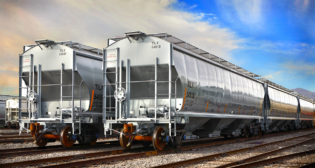
North American Rail Supply and the Global Supply Risk: Why We Should Be Concerned
Written by Robert H. Cantwell, Contributing EditorMy article highlighting China’s strategy to dominate global rail supply and its desire to conquer the North American rail supply market, posted on June 2, 2021, received a lot of attention. This is a follow-up to that article that broadens the scope of risks associated with the global supply of rail products from China and beyond.
Since June 2021, much has happened:
- MBTA Orange and Red Line railcars supplied by CRRC (China Railway Rolling Stock Company) MA have been riddled with problems and delays. According to news reports, problems with electrical shorts, loose brake bolts and derailments led to several removals of the new trains from service. The company blamed supply chain issues caused by the COVID-19 pandemic, but an MBTA official told CRRC MA management it “has completely abandoned its core responsibilities and commitment to lead, monitor and support quality management,” and cited 16 specific failure areas. Workers at the site reported problems with quality tracking, trains being advanced through the assembly process despite missing parts, assembly occurring in the wrong order, and being left with virtually no work for months at a time because a disorderly invoice system failed to reliably pay suppliers for parts.
- China’s slow re-opening from COVID-19 curtailed global supply chains and contributed to inflationary pressures.
- Federal legislation has been passed prohibiting rolling stock procurement from SOEs (state-owned enterprises).
- Many of the more-than 1,000 locomotives supplied to Transnet of South Africa by CRRC have been idled due to a lack of service parts that China has refused to supply over commercial and alleged corruption issues.
- Indian Railways floated a tender for 90,000 railcars over the next three years (30,000/year), an amount two to three times greater than average annual production. Availability of exports will be constrained.
- With Russia’s invasion of Ukraine on Feb 21, 2022, component supply, including wheels and castings, was immediately impacted.
- There have been several examples of China’s “Belt and Road” initiative beginning to fray or collapse, with countries defaulting on the massive debts imposed by those initiatives.
- Closer to home, U.S./China trade relations have become more strained over the future of Taiwan, the use of forced labor, and continued intellectual property theft.
- The U.S. International Trade Commission recently imposed 266% tariffs on rail couplers produced in China in response to unfair trade practices.
Despite these elevated concerns, there is evidence of continued reliance on the supply of rail components from China:

What Experts Said
In 2005, Oliver Wyman published a report titled “Reducing Rail Component Supply Costs and Risks Through Global Sourcing” that advocated global sourcing to drive down costs and reduce supply chain risk. Since this report was released, just the opposite has happened. The Russia/Ukraine war has curtailed supply from Russia, and now with trade tensions with China, reliance on Chinese suppliers indeed comes with elevated risk. Meanwhile, global sourcing negatively impacted the North American rail component supply base, causing company consolidation and closures.
To illustrate the potential risk of global supply, let’s look at the supply of wheels from Russia into North America from 2019 through 2022: Since August 2022, there have been no imports of wheels into North America from Russia, and customers who relied on Russia-supplied product scrambled to find alternatives. They did indeed find alternatives from less risky suppliers, but at perhaps higher prices.

AAR Role In Global Sourcing
The AAR is complicit in the globalization of rail component supply, as all suppliers must be “AAR certified” to supply products to the rail industry. This entails product testing, facility inspections and quality system audits. AAR specifications and standards are also shared globally for all to see. For global suppliers, this support cost is exacerbated—and for what reason, to reduce risk? As detailed in previous articles, there are numerous AAR-certified rail component plants, all of which require on-going auditing and oversight:
- Wheels: 20 AAR-certified, 5 are North American.
- Couplers: 7 AAR-certified, 3 are North American.
- Truck frames and bolsters: 11 AAR-certified, 3 are North American.
- Bearings: 13 AAR-certified, 2 are North American.
Railcar Builders
Strong North American railcar builders are needed for the industry to prosper, yet since COVID, they have struggled to achieve suitable earnings. Railroads, and more recently leasing companies, have prospered, but railcar builders have not. Despite muted deliveries since COVID, builders have been unable to deliver their promised number of railcars, owing to labor and “supply chain” issues. If those supply chain issues are caused by global sourcing, then how much has the builder truly saved after all the expedited freight and production delay costs are factored in, not to mention the market cap impact they had due to missed earnings projections? One builder is in-sourcing the manufacture of certain products previously purchased (onshoring from overseas?). Hopefully this can be done at a cost savings, or at least cost parity—but importantly it addresses the risk question.

Builders are under enormous pressure to increase their gross margins, which come through lower costs or higher prices, and global sourcing has been their fallback—but going forward, global sourcing presents elevated risks. Given the modest outlook for new and converted railcar demand over the foreseeable future, it will be challenging for builders to lower component costs while managing supply chain risk exposure. Furthermore, with this moderate outlook, there is plenty of North American capacity, both component and railcar domestic capacity, to satisfy demand.
Offshore Component Supply
Not all global component supply comes from China and Russia, although they have commanded the lion’s share of rail component imports. Other countries supplying components include:
- Castings (side frames and bolsters): India, Indonesia
- Bearings: Italy, India
- Wheels: Japan, Ukraine, Italy, Brazil, Germany
Developing supply from “less risky” countries (although I can’t imagine how safe Ukrainian supply is these days) may be considered a sound strategy, but it all comes at a cost. Audit costs, oversight and logistics costs, quality costs, etc., all weigh on the sourcing decision. Ideally, investment in North American production is the most desirable alternative.
Summary
The North America freight rail industry remains the envy of the world, but has many challenges ahead, not the least of which is the ability to pivot to growth. Concern about a robust, strong, rail supply chain to support this growth should rank highly as well. At a minimum, understand where your products come from, and identify the potential risk. Don’t be blindsided by another “Russia/Ukraine event.”
As shared previously, I am a free-market capitalist who believes in the benefits of global trade, but in the case of rail supply, I’m not impressed by the overall impact that global sourcing has had on the freight rail industry. I share my articles to educate the industry on the rail component supply chain in hopes that better decisions will be made to ensure the future growth and prosperity of the North American freight rail industry.

Principal of Rail Supply Chain Associates, Robert H. Cantwell spent more than 40 years in executive positions in the rail supply industry. He spent the first 26 years of his rail industry career growing a successful company, Hadady Corp., a designer and manufacturer of truck (bogie) components and systems for locomotives and transit railcars. Following the sale of his business, Bob helped transform Amsted Rail, holding various executive positions for 16 years. He has been active in the Rail Transportation Division of the ASME (American Society of Mechanical Engineers) and is past Chairman of the Division. Bob holds degrees in Mechanical Engineering from the Georgia Institute of Technology and an MBA from the University of Chicago. He possesses a unique perspective on the rail supply industry, combining his engineering experience along with robust economic and financial acumen. As an active investor in the rail industry, he has a vested interest in the success of the industry. He has also actively advocated with members of Congress in support of the rail and rail supply industry. The opinions expressed here are his own.



